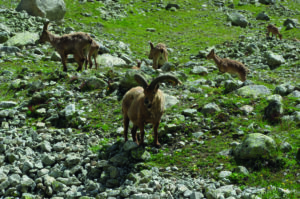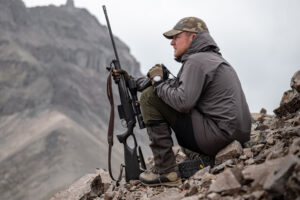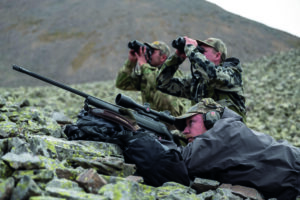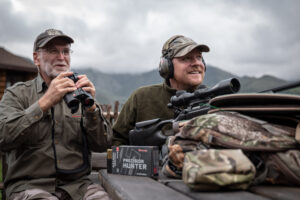Where one good tur deserves another
High in the Caucasus, where the air is thin and the going treacherous, the goat-like tur provide a unique challenge

WRITTEN & PHOTOGRAPHED BY SIMON K BARR
A few years ago, Steve Hornady and I booked to hunt for mid-Caucasian tur in Russia. It had longbeen an ambition of mine to hunt with Steve. I’d known him for many years, but this would be my first trip with him, having to previously postpone. As Steve blithely put it: “I bought a new hip and had my orthopaedist fit it for me.” Now with a new hip, Steve was keen to give it a mountain workout — remarkable given he would be turning 69 in a few short weeks.
We were eager to get going once we arrived to Mineralnye Vody, just north of Georgia. Six checks had been performed on my rifle from home to my final destination, with endless scrutiny and stamping of documents. Hoping to get some rest before what was sure to be a tough journey to camp, it was a relief to hear that we’d be spending a night in the town. But there was a sudden change in plans. Herded into a vehicle, it wasn’t entirely clear what was going on.
We trundled away through the dark streets of the town, stopping once in a back alley to hand over our passports to a figure shrouded in darkness. It didn’t fill us with confidence but, Steve reassured me, this was completely normal, having hunted in Russia many times before.
Through the night we drove south towards the Caucasus, finally stopping at 5am. The light was just beginning to show us what we’d be up against. Verdant hills surrounded us, with distant peaks glimpsed through the early morning cloud.
Promising
Finally, we were granted a few hours’ sleep, before zeroing rifles, sorting gear and stripping our luggage to the minimum for the steep climb ahead. Next, we sat with the guides, poring over maps of the region, looking at promising areas and deciding where we’d set camp. Steve and I agreed to hunt together, despite being told we’d have more chance if we split — an experience shared is an experience doubled, after all.
Under the cover of darkness the following morning, we hoisted ourselves on to horses and set off.
The soft curves of the hills that had seemed benevolent the previous day soon became steep, and the sheep’s wool that covered the saddle failed to cushion its hard iron framework. As we made our way through the green pasture, passing a herd of yak, trees grew ever more scarce and it wasn’t long before we were above the treeline, the misty morning thankfully hiding what lay before us.
All day we rode, covering some nine miles and gaining 5,000ft in elevation. The only respite from the hard saddle came at points too steep for the horses, when we’d get off and lead them. Finally, towards the end of the afternoon, we stopped, pitched our tents among the clouds at 9,500ft and collapsed. It was becoming apparent that our guides weren’t the sympathetic type — tough and inscrutable, the most common phrase we heard was “come, come, come!”
I was in my sleeping bag by 5pm, exhausted — and besides, sitting at the campfire wasn’t an option with the blisters brought on by those saddles, I could only lie or stand.
Determined

The Caucasus tur is surefooted in its mountainous home
After a restless night under canvas, sleeping on rocks, the views of the mountains were refreshing and the chill in the air better than any morning coffee hit. We didn’t hang about, our guides Omar and Sasha were determined to find us animals, as the weather was clear and on our side all day. As we climbed, I realised I wasn’t prepared for this — neither physically nor mentally.
I hadn’t been training as much as I normally would before a mountain hunt and, with work life extremely hectic, I was struggling to focus on the task at hand. As anyone who has experienced mountain hunting knows, focus is essential, for we were now on scree, climbing near-vertical slopes with our feet slipping and sliding beneath us.
While I was struggling with my own demons, Steve developed crippling leg cramp, the pain clearly agonising. He soldiered on through “Going down was terrifying; every step was a danger” it and by lunch time we had gained another 1,500ft. We stopped briefly and the guides had a master plan of nimbly walking around the other side of the mountain to see if they could push some animals towards a bowl we were overlooking on our side. “This never works,” I thought.
We were soon in position and set up, finding a good rest for the rifle and scouting the bowl. If this plan came off it would be ideal, as the furthest point was 220 yards. We waited and watched until finally a female tur and one of this year’s youngsters ambled into sight, followed shortly after by our guides, who reappeared over the edge of the bowl.
There’d be no easy hunt today. A little disheartened, we headed back down the mountain desperate to make camp before nightfall, as steep scree slopes are all the more treacherous in the dark.
Steve’s cramp returned in the night so, the next morning, he decided to take a day’s rest in camp, leaving me to head out. The guides showed me little mercy, never stopping for a breather. After a rather punishing hour after leaving camp and having climbed 1,000ft, it was here that we spotted our first group. However, the scout had seen a more promising prospect in another group, so we decided to try to catch up to them.
The mountains loomed above us, their silence only broken by occasional birdsong and me panting in the thin air as I tried to keep up. Cliffs and boulders scattered the area, but underfoot we were still struggling with small, loose, sharp stones and shale, which required every ounce of concentration. It wasn’t long before the scout confirmed what we had feared — the group had starburst and we were heading towards nothing.
It was decided that we would go back and pursue the first group, which we hoped would still be in the area. Keeping up with the guides had been hard going uphill, but it was terrifying going down, every step a danger, sending rocks skipping down to the cliffs below. We’d have to drop another 1,000ft to get into position, the guides told me.
As we started up again, a group of around 17 tur appeared not 80m away. They’d been in dead ground and we had startled them. They were mostly all young but a mature male had been spotted at the back. Amid the gesticulating and rushed words of the guides, I frantically scanned the hard, flat, rocky ground for a good rest, but we had hit a slope with not a single feature other than shale and there was nothing suitable. The tur were moving, and fast, we needed to decide before they disappeared over the ridge.
Milliseconds
We hunters are constantly faced with tricky decisions: whether or not to take a shot, whether the animal is the right age, or whether to wait for a better prospect. It’s extraordinary what the brain can process in milliseconds. For those hunters who travel to far-flung destinations, the pressure is immense. It may be the only chance you get and the guide will be urging you on. I had trained up to a steady 400m shot with a dead rest and time to consider my bullet path. I had myriad conflicting thoughts and decisions.
I saw the male— a large, mature animal — running on a line slightly higher than the rest of the group. “It’s good, it’s good, shoot, shoot!” the guide was saying as I took my rifle off my shoulder. “Shoot, shoot!” he urged again.
I had no time to range the shot myself so called for a distance. I knew that by now these animals were a good deal further away than 80m and I’d need to adjust my shot. Not only that, but even as I lowered myself I could feel the ground under me shift, my body sliding about on the scree. “Quick, backpack!” I pleaded to the guide. Precious seconds were lost, the guide too keen for me to take the shot to understand what I needed at first.

I grabbed the pack, slid myself down, and found the animal in the scope. “Range, range!” I asked, trying to keep my breathing calm.
The answer wasn’t forthcoming. “How far?” I asked again. The guides discussed in Russian, while I tracked the animal in my scope, using all my muscles to stop myself sliding down the “240m. No, 260m.” I adjusted my aim to compensate for the distance, breathed, and fired. Stones exploded above the momentarily static animal, then it continued on its path, speeding up after being showered with supersonic rock fragments. Textbook mountain slope. Finally they answered: “240m. No, 260m.” I adjusted my aim to compensate for the distance, breathed, and fired.
Stones exploded above the momentarily static animal, then it continued on its path, speeding up after being showered with supersonic rock fragments. Textbook mountain shooting error. I overcompensated for distance, particularly with such an acute angle. I was zeroed dead on at 100m. But the angle and thus the horizontal travel of the bullet meant I needed little or no holdover, even with a 200-gr projectile. Using the integrated ballistic calculator of the Leica Geovid binoculars would have told me this, but time had not been on my side to dial nor even range the target myself.
Now or never
I kept tracking the now three-times- as-fast mature male tur, hoping he might stop, while the guide finally gave regular range updates: “270m… 280m… 290m”. The animal slowed to tackle the ridge to leave our sight. It was now or never. It paused on the crest, as they do, for a split second, giving me the chance I needed. At 356m, I had no time to think, only to act, before he moved again and out of sight. I knew I aimed high at 260m, so taking this and the new angle and distance into account, I squeezed the trigger and the rifle boomed. The animal disappeared over the ridge and out of sight. Was it a hit or miss?
I was sure I’d hit it but, after the first missed shot and with no visual confirmation from the guide, I started to worry. The terrain where the tur had been was unbelievably steep and far too dangerous for all but the most experienced scout to get to. We had an agonising hour wait, watching the scout clamber up the cliff top to see if there was any sign. As he got to the point at which the tur had been standing, I held my breath. We could see him peering down over the rocks, straining this way and that. Finally, straightening his arm in the air, he gave a signal. Found.
Where the tur died was too precarious for me to get to, a sheer 300m drop below to the ledge he lay upon. The experienced guide caped off the 100kg animal and had to leave the carcass where it lay. It was simply too dangerous to bring it back to camp. However, this meat would not be wasted. This range was a stronghold for the threatened eastern imperial eagle. We had seen several circling the mountains as we hunted and this tur would make good feeding for many eagles for days to come.
An hour later the guide returned with the unusual-looking horns and cape on his back. This looked like it was from Mordor just beyond Middle Earth, not the Caucusus. Steve had spent the day recovering and making camp somewhat more cheerful, building stone seats around the fire. I could nearly sit again. He shared in my joy and we spent the evening in a more jolly frame of mind, spurred on by success. The deprivations and discomforts of the previous days were soon forgotten and sleep came more easily that night.
The next day dawned and we headed out early. Having rested, Steve was ready for his hunt. It wasn’t that the terrain was easier, nor that we were suddenly fitter, but optimism goes a long way, which helps when you have to climb. There was no reappearance of the cramps for Steve and, after a long day’s walking, we found a group that included a mature male. This time there was breathing space and a better rifle rest, and Steve took his shot. Unseen, however, was the steep cliff below a ridge and the animal tumbled down, out of view.
By this time, the light was starting to fade and, knowing we had a long descent, there was no option. The guides would have to return for Steve’s tur because it was too dangerous to attempt that day.

Inspiration
It was several more days before Steve’s tur was found, when we were back among the comforts of home, but I was relieved to hear Steve would have a permanent reminder of our adventure. Hunting with someone who has so much experience of mountain hunting is an inspiration for what I hope to achieve. With some 40 mountain hunts under his belt, Steve has hunted 20 goats and 26 sheep, most of which are from different species.
As he told me when he shared the news that his tur was recovered, he’d found our Russian trip hard. “I’d say this was the most challenging I’ve been on — my lungs were okay, but the treacherous terrain was tough. And going downhill was plain dangerous.”
I think we both underestimated what a challenge this would be.

Simon’s Kit List
Sauer 404 XTC in .300
Win Mag
sauer.de
Leica Magnus i 1.8-12×50
riflescope
leica-camera.com
Leica Geovid 10×42 HD-B
3000 binoculars
leica-camera.com
Hornady 200-gr ELD-X
edgarbrothers.com
Swazi Tahr Ultralite smock
swazi.co.nz
Swazi Driback pants
swazi.co.nz
For more information about hunting mid-Caucasian tur, visit: profihunt.com








